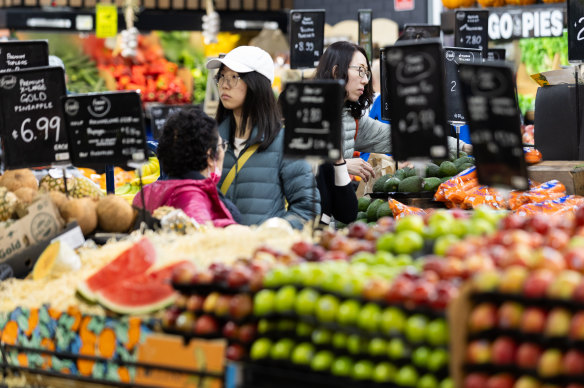By Shane Wright
The Reserve Bank will have to consider an interest rate rise at its next meeting after an unexpectedly large lift in monthly inflation showed stubborn price pressures across large parts of the economy even as consumers are forced to wind back spending.
The annual rate of inflation jumped to 4 per cent in May, from 3.6 per cent in April, as prices on goods and services, from housing to food, lifted. The closely watched measure of underlying inflation also climbed, to 4.4 per cent from 4.1 per cent.

While overall prices fell in May, higher-priced fruit and vegetables have contributed to a rise in inflation to 4 per cent.Credit: Jason South
Overall inflation actually fell 0.1 per cent from April to May, with petrol prices dropping for the first time since the start of the year while there were small declines in dairy goods, clothing, gas and communication. However, the drop was not as large as the 0.3 per cent fall recorded in May last year, pushing up the annual rate.
The high monthly number prompted analysts to declare the Reserve Bank board meeting in early August would be live. Financial markets put the chance of a rate rise at better than two in five, more than double the expectation before the release of the inflation figures.
Quarterly inflation data, which is less volatile than the monthly data and takes in all parts of the economy, is due to be released at the end of July. It will have a strong bearing on the RBA possibly taking the official cash rate to a 13-year high of 4.6 per cent in August.
Betashares’ chief economist David Bassanese described the figures as a “shocker”, saying they suggest price pressures remain broad due to a range of factors including immigration, public infrastructure spending, growing demand for health services, housing shortages and climate-related increases to energy and insurance costs.
“The upshot of today’s result is that it places enormous pressure on the Reserve Bank to not only not cut interest rates anytime soon, but potentially lift them further,” he said.
One of the largest increases in the month was the price of fruit and vegetables, which lifted by 2.3 per cent in May and has increased by 8 per cent since the start of the year. But dairy prices dropped by 0.4 per cent last month and are 0.7 per cent lower than at the start of the year.
New home construction prices have climbed 4.9 per cent over the past year, well down from their annual peak of almost 22 per cent in mid-2022, while rents have lifted by 7.4 per cent.
Electricity prices lifted by 1.4 per cent in the month to be 6.5 per cent up over the year, largely due to energy relief rebates being used up by households. Those rebates will restart with the new financial year.
Without the rebates, electricity prices would have climbed by 14.5 per cent over the past 12 months. Gas prices, by contrast, have fallen by 3.9 per cent since May last year and are now at their lowest level since the end of 2022.
Treasurer Jim Chalmers said the figures showed inflation would be higher if not for the government’s actions, noting the monthly indicator could jump around.
“As we’ve said many times before, the monthly CPI number is volatile and can jump around because not every item in the basket is updated each month,” he said.
But shadow treasurer Angus Taylor said the government was amplifying Australia’s inflation problems by its spending.
“We’ve now had four months in a row of accelerating core inflation. This will no doubt be of concern to the independent Reserve Bank,” he said.
EY chief economist Cherelle Murphy said the June quarter inflation report, due just ahead of the August meeting, would be pivotal to the next move in interest rates.
“All things considered, it’s likely to point to inflation being too high, so our view is the cash rate will at least need to remain restrictive for some time. A rate hike is not out of the question, given the Reserve Bank has little tolerance for upside surprises,” she said.
The figures were released before a speech by RBA assistant governor Christopher Kent, who told a banking conference in Melbourne that the 40 per cent of the population with mortgages were feeling the most direct impact of higher official interest rates.
He said the cash rate had helped push mortgage repayments as a share of household disposable income to a record 10 per cent.
“Households have been responding to higher interest rates. While households with mortgages are significantly affected, and quite directly, consumption growth is weak for most people,” he said.
“Restrictive financial conditions are helping to slow the growth of demand, thereby bringing the level of demand into better balance with supply. This is contributing to the decline in inflation, which is to the benefit of all Australian households and businesses.”
Cut through the noise of federal politics with news, views and expert analysis. Subscribers can sign up to our weekly Inside Politics newsletter.